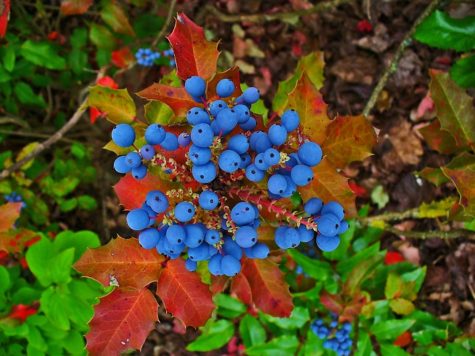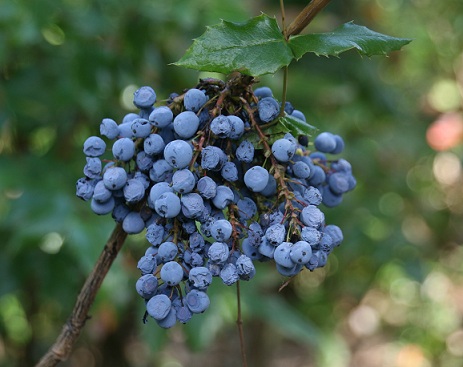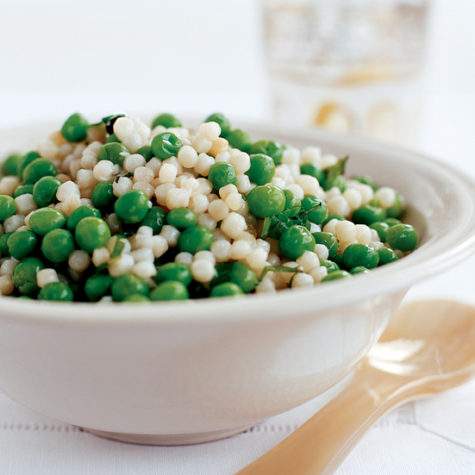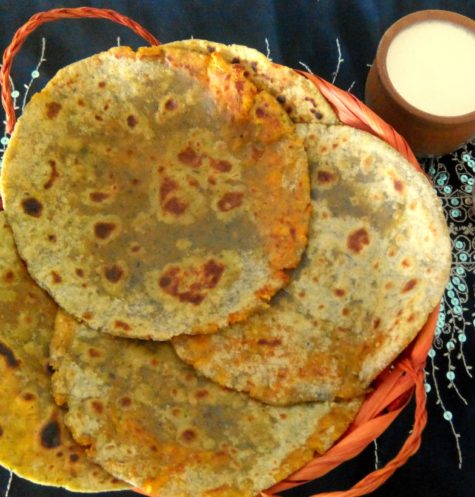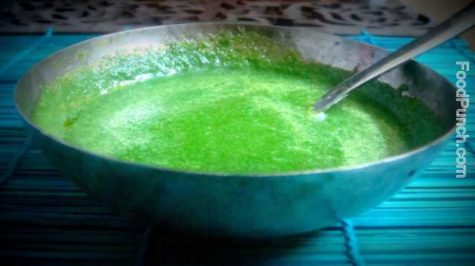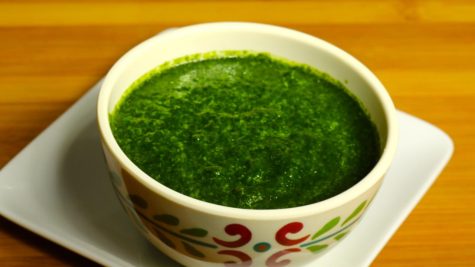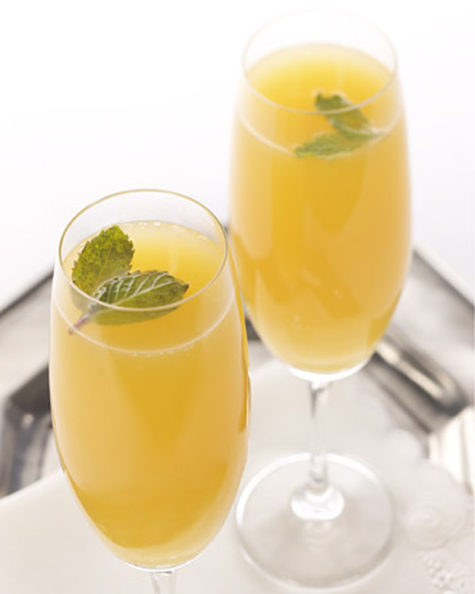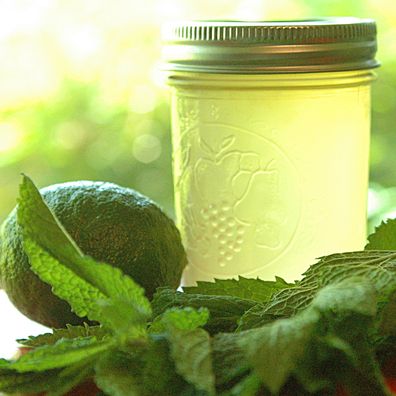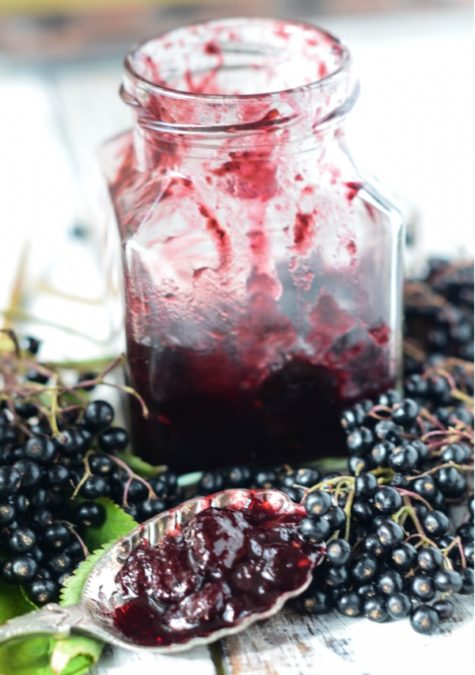Monthly Archives: January 2017
Bilberry Jam
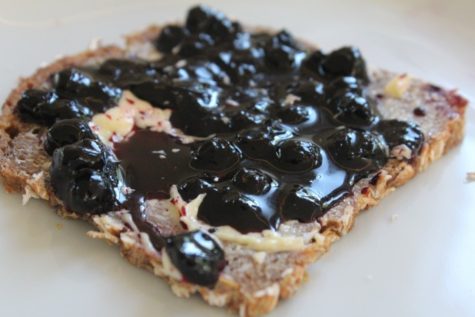
Bilberry is used for improving eyesight, including night vision. In fact, during World War II, British pilots in the Royal Air Force ate bilberry jam to improve their night vision. Bilberry is also used for treating eye conditions such as cataracts and disorders of the retina. There is some evidence that bilberry may help retinal disorders.
Here’s a recipe:
Put 3 lb. of clean, fresh fruit in a preserving pan with 1 1/2 lb. of sugar and about 1 cupful of water and bring to the boil. Then boil rapidly for 40 minutes. Apple juice made from windfalls and peelings, instead of the water, improves this jam. To make apple juice, cover the apples with water, stew down, and strain the juice through thick muslin. Blackberries may also be added to this mixture.
If the jam is to be kept long it must be bottled hot in screw-top jars, or, if tied down in the ordinary way, more sugar must be added.
From: A Modern Herbal
Oregon Grape Lavender Jelly
Our modern palate oscillates between the addictive flavors of salty and sweet, but we have lost an essential ingredient to optimal health: bitter plants. They are so rare in our diet that many people cannot name anything with bitterness except coffee. Historically, humans valued bitters for their digestive stimulating and medicinal properties. Oregon grape is a quintessential bitter plant that has the capacity to cleanse, clarify and enliven body and spirit.
Here’s a simple step by step recipe for Oregon Grape Lavender Jelly (Low sugar):
Measure 8 cups of clean, rinsed Oregon grape berries. Place berries in a cooking pot with 2 cups of water. Bring to a boil, turn down and simmer for 15 minutes. Use a large spoon to mash the berries against the side of the pot so the juice is released.
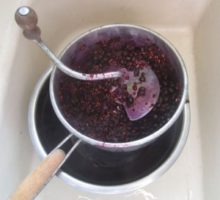 Place a Foley food mill over another cooking pot. In 1 to 2 cup increments, turn the berries and juice through the food mill so that the seeds are separated. Remove the seeds from the mill before straining another batch.
Place a Foley food mill over another cooking pot. In 1 to 2 cup increments, turn the berries and juice through the food mill so that the seeds are separated. Remove the seeds from the mill before straining another batch.
Measure 4 cups of the juice/pulp. Place the juice in a cooking pot. Stir in 2 teaspoon of calcium water (included in Pomona’s Pectin, and 2 tablespoons of fresh or dried lavender.
In a separate bowl, measure 2 cups of honey and stir in 2 teaspoons of pectin.
Bring the juice in the cooking pot to a boil. Add the honey/pectin and stir vigorously for 1-2 minutes until the mixture returns to a boil. Remove from heat.
Place the jelly in clean hot canning jars, wipe the top of the jars to remove any spillage, cover with lids, and can in a water bath for 10 minutes. If any lids do not seal, refrigerate the jar of jelly and use within three weeks.
Oregon Grape Jam
Oregon grape was often used by several native North American Indian tribes. The blue fruits are tart and improve after frost. They are often gathered for jelly or wine. Used to treat a wide variety of ailments, Oregon Grape species contain the extremely potent alkaloid, berberine, (also found in goldenseal) which is antiseptic and stimulates the liver and spleen.
Ingredients:
- 1 quart Oregon Grapes (Mahonia aquifolia or other Mahonias)
- 3 apples, peeled, cored and cut into small pieces
- 1 box fruit pectin
- 7 1/2 cups sugar
- 1 – 12 oz can frozen concord grape juice concentrate
- Enough water ready to add to grape, apple pulps and juice concentrate to make the measurement of 6 cups.
- 8 – 8oz jars, lids and rims
Take out about 1/4 cup grapes and a heaping tablespoon of small apple pieces and set aside. Then follow the cooking steps for grape jam inside the pectin package adding the set-aside fruits to the jars just before sealing. If you don’t have enough wild Oregon Grapes at one time, you can freeze them until you have enough.
This recipe is from a woman in Coquille, Oregon, which is along the southern Oregon Coast. Her name is Rachel Ordway Smith. She has other recipes using fruits from northwest native plants on her web site at Arts Desire
Israeli Couscous With Mint
Ingredients:
- 1 1/2 cups Israeli couscous (8 ounces)
- 4 tablespoons unsalted butter
- 1 tablespoon very finely chopped garlic
- 3/4 cup frozen baby peas, thawed
- Salt and freshly ground pepper
- 2 tablespoons finely chopped mint
Instructions:
Bring a medium saucepan of salted water to a boil. Add the Israeli couscous and cook until al dente, about 4 minutes. Drain the Israeli couscous, reserving 1 1/2 cups of the cooking liquid; wipe out the saucepan. 
Melt 2 tablespoons of the butter in the saucepan. Add the chopped garlic and cook over moderate heat until softened. Add the baby peas and toss to coat. Add the couscous, the remaining 2 tablespoons of butter and 1 cup of the couscous cooking liquid and simmer, stirring occasionally, until the couscous and peas are tender and coated in a creamy sauce, 3 to 4 minutes. Season the couscous and peas with salt and pepper and stir in the mint. Stir in some of the remaining cooking liquid if the couscous seems dry. Transfer the couscous to a bowl and serve.
From Food and Wine
Mint Flavored Indian Bread
- 1 cup whole wheat flour
- 1 cup all purpose flour
- 3 tbsp vegetable oil
- ¼ cup fresh peppermint leaves, finely chopped
- 1/8 cup fresh coriander leaves, finely chopped
- 2-3 green chilies, finely diced
- 2-3 pinches of kalaunji/mangraila (nigella)
- 1 tsp of salt
- Water to knead the dough
- Ghee/Vegetable oil for the paratha
Instructions:
Sieve the flours, salt and nigella together in a large bowl. Then, add green chilies, mint, coriander, nigella and oil, mix well and knead into soft dough adding water a little at a time.
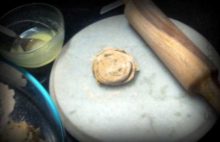 Make equal division of the dough and roll into round chapati. Use a knife and cut the chapatti from outer edge to the inner end in circular stroke (making a whirlpool pattern). Roll up these strips from end to end making a ball (as shown in the photo) and then roll it out into semi-thick paratha, rolling flat from just one side.
Make equal division of the dough and roll into round chapati. Use a knife and cut the chapatti from outer edge to the inner end in circular stroke (making a whirlpool pattern). Roll up these strips from end to end making a ball (as shown in the photo) and then roll it out into semi-thick paratha, rolling flat from just one side.
Heat a flat skillet (tava) and cook each paratha using ghee/vegetable oil till they are nice crisp and golden pink. Sprinkle some cut mint on the parataha, flip it over on the hot skillet and serve hot.
This recipe makes 4 to 6 medium size parathas.
Dos and Don’ts:
DO:
You may add 2-3 bulbs of finely diced garlic if you like.
Also some people do add carom seeds; it is believed to improve digestion.
DON’T:
Do not add too much water while kneading the dough all at one go.
Adding a little water at a time helps knead soft dough.
From: Food Punch
Green Coriander Chutney
Ingredients:
- 200 gms fresh Green Coriander
- 5 Garlic cloves
- 2 tablespoon Lemon Juice
- 2-3 Green Chilies
- Salt to taste
- A drop of Mustard/Olive oil to dress up.
- Optional – 2 tablespoon of grated unripe mango or a small tomato to add the tang..
Add all ingredients except Lemon juice in a Mixer Grinder. Make a thick past adding water just enough to make the paste. Pour this chutney in a glass bowl and add the lemon juice and a drop of Mustard or olive oil, mix well and serve with Pudina Parantha (Mint Flavored Indian Bread) and Chicken Korma(Chicken in thick Indian Style Gravy).
Dos and Don’ts:
DOS:
You may add a dash of ginger if you like,
Some people also like to add Aamchur powder for the tang..
DON’TS:
Be cautious while adding chilies, quantity must be adjusted to your taste and depending on how hot the chilies are.
Add water just a little at a time, too much of it in one go might spoil the consistency of the paste.
From: Foodpunch.com
Mint Chutney
Mint chutney is a delicious condiment, blend of mint and cilantro combined with spices. Most Indian snacks are incomplete without chutney. Chutney also tastes great with a main meal. Try using mint chutney as a spread for your sandwiches – it tastes great!
Recipe will serve 6.
Preparation time 15 minutes
Cooking time 10 minutes
Ingredients:
- 1 cup packed mint (podina) leaves all the stems removed
- 1 cup packed Cilantro (hara dhania) roughly chopped
- 2 tablespoons green chilies chopped (adjust to taste)
- 2 tablespoons lemon juice (adjust to taste)
- 1/2 inch ginger chopped
- 1 teaspoons salt (adjust to taste)
- 2 tablespoons sugar
- Pinch of asafetida (hing)
- Approx. 3 tablespoons water use as needed
Instructions:
Blend all ingredients, except the mint and cilantro, into a paste. Add mint and cilantro, a little at a time, and blend until smooth. Add water as needed. Taste and adjust salt, green chilies, or lemon juice as desired. Tastes great with samosa, vegetable pakoras….
Suggestions:
You can make mint chutney in large quantity in advance and freeze it in ice cube trays. Store the frozen cubes in a zip-lock plastic bag. When ready to serve, defrost as many cubes of mint chutney as needed.
Note:
The most common mint used in Indian cooking is Podina or Peppermint. However, any variety of mint can be used. Just be aware that the flavor will not be quite the same.
From: Manjulas Kitchen
Mimosas with Fresh Mint and Oranges
This is a very cooling summer drink.
Ingredients:
- 1 orange
- 2 cups fresh orange juice
- 1 cup sparkling wine or champagne
- 1 to 3 drops peppermint essential oil (to taste)
- 4 fresh mint leaves, for garnish
Slice orange in half. Cut two thin slices of the orange & save them to use as a garnish. Stir orange juice together with the sparkling water, add the peppermint oil.. Serve in champagne flutes & garnish each glass with two mint leaves & one thin orange slice.
Note: Sparkling mineral water or ginger ale can be substituted for the wine.
Fresh Peppermint Jam
Fresh Peppermint Jam:
- 250 g of peppermint leaves
- 1 kg of sugar
- 2 lemons
- 0.5 liters of water
Wash mint leaves with stems, dry slightly and chop. Cut lemons into small pieces with the skin. Put everything into the pot and boil for 10 minutes. Leave for a day. Filter the infusion, add the sugar and cook until tender. Pour hot boiled jam into jars and close tight.
From: Herbal Picnic
Elderberry Chutney
Here we have 2 very old recipes for Chutney made with Elderberries:
- 2 lb. Elderberries,
- 1 large Onion,
- 1 pint Vinegar,
- 1 teaspoonful Salt,
- 1 teaspoonful ground Ginger,
- 2 tablespoonful Sugar,
- 1 salt spoonful Cayenne and mixed spices,
- 1 teaspoonful Mustard seed.
Stalk, weigh and wash the berries; put them into a pan and bruise with a wooden spoon; chop the onion and add with the rest of the ingredients and vinegar. Bring to the boil and simmer till it becomes thick. Stir well, being careful not to let it burn as it thickens. Put into jars and cover.
Second Recipe:
- 1 1/2 lb. of Elderberries
- 1 Onion
- 6 Cloves
- 1/4 oz. ground Ginger
- 2 oz. Demerara Sugar
- 3 oz. Raisins
- a dust of Cayenne and Mace
- 1 teaspoonful Salt
- 1 pint Vinegar.
Rub the berries through a wire sieve. Then pound the onion with the spices, raisins and salt. Add the vinegar and put all in an enameled saucepan and boil with the pulp of the berries for 10 minutes. Take the pan from the fire and let it stand till cold. Put the chutney into jars and cork securely.
From: A Modern Herbal
Note: Most species of Elderberry are edible when picked ripe and then cooked. Both the skin and pulp can be eaten. However, it is important to note that most uncooked berries and other parts of plants from this genus are poisonous. European Elderberry (Sambucus nigra) is the variety that is most often used for health benefits as it is the only variety considered to be non-toxic even when not cooked.
